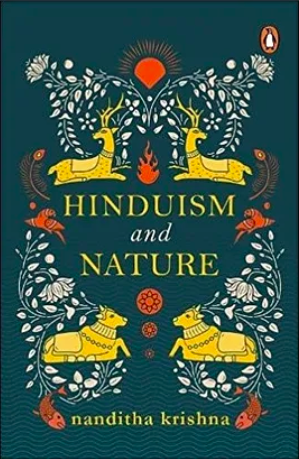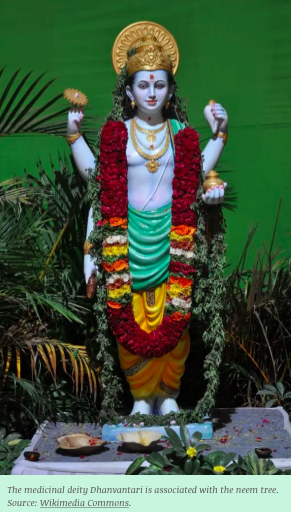Hindu Connections to Nature (various authors)
Excerpts below taken from the full article on SwarajyaMag.com.
“The unity in diversity – a key ecological principle – is also the very basis of India’s nationhood and the uniting principle of Hinduism.
This makes the new work of Dr Nandita Krishna, ‘Hinduism and Nature’ (Penguin, 2017), a book to be read seriously.
In her introduction, she points out that the Vedic and Harappan cultures ran simultaneous rejecting the conventional Western Indological model that the Vedic myth of slaying of Vritra was a reflection of Aryan hordes destroying the dams and barrages built by Harappans – an Aryan invasion scenario developed later by Marxist historiographer D D Kosambi.
The unique relation of Hinduism to nature, according to Dr Krishna, comes from the Vedic creation hymns, which despite their pluralism, emphasize the non-dual nature of the creator and the creation. The concepts of dharma and karma emerge as important guiding principles in determining the relation of Hindu community to nature not only through the overarching worldview but also through daily rituals and activities. She says that "the earth and its inhabitants are part of a highly organized cosmic order called rita and any disruption results in a breakdown of peace and the natural balance”. However, one feels that rita deserves a more detailed treatment in the context of nature and Hinduism. (In fact rita is the basis for Vedic worldview and the substratum on which the view of nature rests. There is also a strong possibility that the Tamil word for dharma, ‘aram’ itself may be etymologically related to rita through the PIE *ar from which the old Persian word aram is also derived which too means right direction.)
The author does not restrict herself to the Sanskrit literature. She also points to the ancient Tamil culture. Citing Sangham literature and also pointing out the ecological wisdom enshrined in the five eco-cultural divisions of Aynthinai in Tamil literature, she presents a pan-Indic Hindu civilizational picture. This is a very welcome step as usually the concentration is only on the Sanskrit aspect of Hindu culture alone. What is even more important is that both the Sanskrit and Tamil literary depictions show a fundamental unity of Hindu culture and hence reinforces the organic oneness of the ancient nation.
The relation between Hinduism and nature is not something that is delineated in the abstract and high philosophies of systems like Vedanta and Samkhya. The author rightly points out that "there is a very strong and intimate relationship between the biophysical ecosystem and economic institutions”. In fact, the entire book is in a way a lucid description of these relations and how they already help and can be even more actively harnessed in the conservation of nature. The introduction chapter, which forms the first 24 pages of the book, provides an insider view of how a Hindu looks at her religion and its relation to nature.
The second chapter on sacred groves and gardens is also equally interesting…”
—Aravindan Neeelakandan, read full article here.
##
Excerpts below taken from the full article on PsychiatricTmes.com.
EARTH & PSYCHIATRY: Understanding the Hindu Worldview
The World is One Family
“Nature is an integral part of religion. Religion serves as a bridge between humans and the environment by using rituals to mark the rhythm of the seasonal changes, to express gratitude for a bountiful harvest, and pray to keep away destructive natural forces. Many religions teach that humans are the caretakers of this planet earth. The beliefs about human-nature relationships, religious cosmologies, and climate change perceptions are a set of interrelated concepts, reinforced and shaped by one another. How might we approach climate change from the Hindu point of view?
It is critical to understand how various cultures function concerning nature. Hindu religion is a multifaceted faith with numerous perspectives on human-nature relationships.(1). There is no central authority that prescribes and proscribes universally accepted human behavior to all Hindus. There is a description of unity in all diversity: “Vasudhaiva Kutumbakam,” meaning “the whole world is a family” in Sanskrit.
Hinduism teaches that the 5 significant elements (space, air, fire, water, and Earth) that constitute the environment are all derived from prakriti, the primal energy. Each of these elements has its own life and form; together, the elements are interconnected and interdependent. Hinduism recognizes that the human body is composed of and related to these 5 elements. Each element is connected to 1 of the 5 senses. The human nose is related to Earth, tongue to water, eyes to fire, skin to air, and ears to space. This bond between our senses and the elements is the foundation of our human relationship with the natural world. For Hinduism, nature and the environment are not outside us, not alien or hostile to us. They are an inseparable part of our existence, and they constitute our very bodies.
The Upanishads explain the interdependence of these elements in relation to brahman, the supreme reality, from which they arise: “From Brahman arises space, from space arises air, from air arises fire, from fire arises water, and from water arises earth.”
In Hinduism, the concept of dharma is considered to be a universal organizing principle that governs all reality. Thus, protecting the environment has been considered by some as Hindu dharma. Another central concept of Hinduism is karma, which holds that every action has consequences and that there is a causal relationship between one’s actions and one’s future fate, even in subsequent lifetimes. Thus, karma is also closely related to the concept of rebirth, or samsara. Both concepts further illustrate the Hindu conception of the human-nature relationship in 2 ways: 1) there is a continuity and an intimate relationship among all forms of beings on Earth, and so it is essential that no harm is done to any of them; and 2) one’s behavior toward the environment will have karmic consequences, which means one can accumulate good karma by actively protecting the environment.
Another Vedic text—the Atharva Veda—has mantras that remind Hindus of the need to behave respectfully toward Mother Earth by making sure that any personal activities do not hurt her vitals, body, or appearance. The Hindu Puranas are one such collection of Hindu myths and traditional lore. For example, some are related to the Ganges River, or Ma Ganga, which is depicted as a goddess who descended to Earth to save the world. The Ganges River is thus perceived to be a sacred place where believers can remove their sins by touching or consuming the water, and the river is an essential site for worshipping rites and rituals in India.(1)”
—Nyapati R. Rao, MD, MS, DLFAPA, full article here.
(1) 1. Tay P. Can religion teach us to protect our environment? Analyzing the case of Hinduism. Ethics & International Affairs. April 2019. https://www.ethicsandinternationalaffairs.org/2019/can-religion-teach-us-to-protect-our-environment-analyzing-the-case-of-hinduism/
Graphic from Hitavada.com (“The People’s Paper”).
##
Excerpts below taken from the full article on Arborculture.
TREES AND RELIGION: HINDUISM
“Hinduism, which also arose from the ancient Vedic religion, also placed marked value upon trees (and plants, in general). With regards to the philosophical outlook on plant life, in contrast with Buddhism, there is a clearer and prevailing view of plants being taken into moral consideration. Granted, it must be stressed, prior to further explanation, that Hinduism itself has at least six different offshoots that have distinct differences between one another, and therefore it is the core texts that are generally referred to (Hall, 2011). This clearer view on plant life is because Hinduism generally considers all beings as being connected via Brahman, and as a consequence plants possess consciousness and are therefore sentient (Framarin, 2014b), and trees are even self aware according to the Yogavasistha (Hall, 2011). Consequently, plants are part of the cycle of death and rebirth, known as samsara. Whether this is sentience in the human sense, or simply because plants are alive, is however questioned by in another text by Framarin (2014a). However, one can observe how trees, in particular, were considered to be able to experience happiness and sorrow, as detailed in the ancient Puranas (Dwivedi, 1990).
Regardless of exact outlook, the fact that Hinduism recognises plants as at least living beings has implications towards their attitude towards plants, which is one of non-violence. Despite this, in the case of whether a plant must be sacrificed to save a human, it is considered that humans have greater moral standing, by virtue of their heightened sentience and their mobility (Hall, 2011). This outlook may however only be more recent, as more historic Hindu texts suggest that all life is of equal sanctity and must be safeguarded (unless there is adequate justification to do otherwise), because only God has dominion over all life (Dwivedi, 1990). In light of the aforementioned, it is of little surprise that conservation issues are becoming more pertinent within Hindu cultures, and particularly within the middle-upper class societies that can afford to care (Tomalin, 2004).
With specific reference to trees, it is not surprising that it is the religiously- and economically- important trees that are most actively associated with the religion and culture. To begin, it is however necessary to recognise that Hindus consider all trees to have a tree deity, which can be worshipped and provided with offerings including water and sacred threads. These tree deities do lead trees to adopt a position of significant religious importance (Dwivedi, 1990), though nonetheless, some trees will hold particularly acute religious importance; and notably those that have direct associations with principal deities. For example, Shitala (the goddess of poxes) is considered to reside within a neem tree (Azadirachta indica) – perhaps because neem has been used to treat an array of poxes and other illnesses for many centuries (Edwardes, 1922; Norten & Pütz, 2000) – and as a result the neem tree is considered sacred (Hall, 2011). The medicinal god Dhanvantari also has associations with the tree. In fact, the neem may even be of divine origin, as the Hindu demigod Garuda was thought to have spilled a few drops of the elixir of immortality onto the tree, on his way to Heaven with the elixir (Puri, 1999). Neem leaves may also be used to ward off evil spirits, immediately after childbirth (Edwardes, 1922).
The goddess of fortune and prosperity, Lakshmi, is also found to reside within a tree – the sacred fig, or pipal (Ficus religiosa) (Hall, 2011). In fact, the three principal gods in Hinduism, Brahma, Shiva, and Vishu, all have associations with the sacred fig tree. The gular (Ficus racemosa) also has associations to all three of these gods: the roots Brahma, the bark Vishnu, and the branches Shiva (Krishna & Amirthalingam, 2009). Vishu is also associated with the banyan (Ficus benghalensis) and sometimes wholly portrayed as the gular (Ficus racemosa) (Chandrakanth & Romm, 1991), whilst Shiva has associations with the bel (Aegle marmelos), where leaves are used to worship Shiva, in order to gain redemption from a sinful act (Jagetia et al., 2005; Niroula & Singh, 2015), and also maulsari (Mimusops elengi).”
—See full article here, see Arborculture’s series on Trees in Religion here (first link in each header).
##
Excerpts below taken from full article on TheHindu.com.
“Our biodiversity, our life, our future
Life is unique to our planet. It is earth's most precious asset. And there is plenty of it. We do not know the exact number of species: many estimates range from 10 to 12 million. India may have close to a million species, the vast majority of which remain to be named or described. These hundreds and thousands of species in India live in many different types of ecological communities or ecosystems spread from deep seas to mountain tops.
The extraordinary richness of life that surrounds us in the form of diverse arrays of organisms, ecological communities, and natural landscapes, also called biodiversity, sustains such human activities as agriculture, forestry, and fisheries, and is the basis of our civilisation. The fossil fuels such as coal, oil and natural gas that support our industry are derived from plants and animals that dominated life on earth millions of years ago. Biodiversity also has immense aesthetic, cultural, and spiritual value.
This biodiversity, a product of billions of years of evolution, has been rapidly declining in recent years — a victim of humans' large ecological footprint on earth. Climate change will exacerbate the rapid loss. Because of our intimate association with biodiversity, with the loss of biodiversity, we face the prospect of losing ourselves. We therefore urgently need to document life, and at the same time assess changes in biodiversity and curtail its loss.
Richness of life
We know the life around us is immensely rich: everyday we see a great variety of organisms around us. Our own bodies provide great examples of this diversity. Humans carry hundreds of different species of bacteria — critical to the performance of our bodily functions. Biologists have indeed described hundreds of thousands of species on earth. Yet, much of the diversity of life on our planet remains to be described. Out of an estimated 12 million species on the planet, only 1.8 million species have been named and described.
or India, perhaps no more than 100,000 of the estimated one million species have been described. The rate of description of new species for India does not exceed 300 per year. With about 900,000 species that remain to be described and discovered, it will be several millennia before India's biodiversity is fully catalogued.
The science of discovering, describing, and cataloguing species — taxonomy — has been in a state of decline for decades even though cataloguing of life forms the basis of conservation — we cannot conserve, if we do not know what to conserve. The sense of urgency for strengthening taxonomy and its sister discipline systematic biology is underscored not only by ever increasing loss of biodiversity, but also by the need to fight diseases in humans and agricultural pests, to meet new challenges in agriculture, forestry and fisheries, and to examine ecological impacts of genetically-modified organisms.
India, like almost all other places in the world, has unique biodiversity. However, the number of species that are unique to India is high. Biologists have identified 34 global hotspots of biodiversity. These hotspots have two common features: a very high rate of biodiversity loss, and high proportion of endemic species or species that are unique to that particular hotspot. The landmass of India incorporates four of these 34 global hotspots: the Western Ghats, the Himalayas, Indo-Burma (northeast India, south of Brahmaputra) and Sundaland (Nicobar Islands). We do not have up-to-date species lists even for our protected areas such as national parks, tiger reserves, and wildlife sanctuaries, let alone hotspots of global significance.
We need to review and strengthen our efforts…”
— Kamaljit S. Bawa, full article here.
Photo from Prayatn Society for Environment Conservation.
###
Cover image, “A devotee offers prayer in the water during the Ujjain Kumbh. (Arun Mondhe/Hindustan Times via GettyImages)” available here.
These excerpts shared as part of our 2022 collection, Restoring Connective Tissue.










